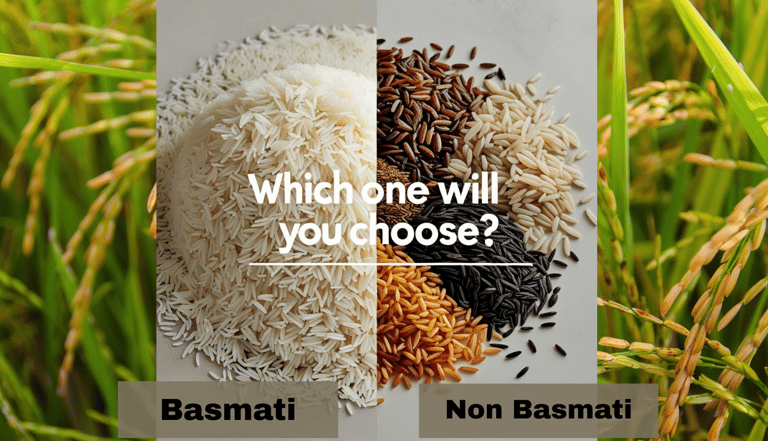Basmati vs Non-Basmati Rice: What’s the Real Difference?
If you've ever wondered what really sets Basmati and Non-Basmati rice apart, you're in the right place. Both are staples in Indian kitchens and global exports — but they’re not the same when it comes to taste, texture, nutrition, and use.
6/21/20254 min read


Basmati vs Non-Basmati Rice: What’s the Real Difference?
If you've ever wondered what really sets Basmati and Non-Basmati rice apart, you're in the right place. Both are staples in Indian kitchens and global exports — but they’re not the same when it comes to taste, texture, nutrition, and use.
Whether you’re a home cook, exporter, or someone exploring Indian rice varieties, this post will help you understand the real difference between the two — in a way that's easy to grasp.
What is Basmati Rice?
Basmati rice is like the royalty of Indian rice, cherished for centuries not only in India but across the globe. It’s primarily grown in the northern plains of India in the fertile regions of Punjab, Haryana, and parts of Uttar Pradesh, where the unique climate and soil conditions help it thrive. This variety is known for its long, slender grains, distinct nutty aroma, and ability to elongate beautifully and remain fluffy when cooked. Its rich history, aromatic appeal, and light texture make it a top choice for premium dishes like biryanis and pulao.
What is Non-Basmati Rice?
Non-Basmati rice refers to all the other types of rice grown across India. Non-Basmati rice grains vary widely in shape and size – some rice grains are short and plump, while others are round and flat. From IR64 and Sona Masuri to parboiled, broken, and red rice, the varieties are endless. These are mostly grown in Eastern and Southern India and are used widely in daily meals, bulk cooking, and traditional regional dishes.
Key Differences Between Basmati and Non-Basmati
Grain Shape:
Basmati has long, thin grains that elongate when cooked.
Non-Basmati grains can be short, medium, or long — and often get sticky.
Aroma:
Basmati has a natural, nutty fragrance.
Non-Basmati usually doesn’t have any distinct aroma.
Cooking Texture:
Basmati stays fluffy and separate.
Non-Basmati may be sticky or soft depending on the variety.
Geographic Origin:
Basmati is specific to the Indo-Gangetic plains (GI-tagged).
Non-Basmati is grown across India — including the South and East.
Price:
Basmati is a premium rice and more expensive.
Non-Basmati is budget-friendly and ideal for bulk use.
Export Demand:
Basmati is popular in the Middle East, USA, and Europe.
Non-Basmati is widely exported to Africa, Southeast Asia, and Bangladesh.
Nutritional Benefits of Basmati Rice
Low Glycemic Index (GI): Basmati has a lower GI compared to other white rice, which makes it better for blood sugar control.
Good source of carbs: Provides long-lasting energy.
Less sticky starch: Easier to digest and less likely to spike blood sugar.
Low in fat and sodium: Naturally heart-friendly when cooked without oil.
Pro Tip: Go for aged Basmati — it’s lighter, fluffier, and even better in aroma and texture.
Nutritional Benefits of Non-Basmati Rice
High fiber in whole grain types: Especially in red rice, brown rice, and unpolished rice.
Great for gut health: Parboiled rice retains more nutrients like iron, potassium, and calcium.
Affordable nutrition: A staple source of energy and micronutrients for millions.
Ideal for large-scale meals: Balanced carbs, quick energy, and easy to cook in bulk.
Culinary Uses of Basmati Rice
Biryani – The hero of any festive table. Basmati rice is perfect for biryani as it remains separate and fluffy, absorbing the rich spices and flavors while still holding its shape.
Pulao and Fried Rice – Keeps grains separate and aromatic. Pulao made with basmati is light, fragrant, and ideal for pairing with vegetarian or meat sides. Fried rice gains an elevated texture when made with day-old basmati.
Royal or Mughlai Cuisine – Often served with gravies and kebabs. The long grains of basmati complement creamy gravies and grilled dishes, making every bite luxurious.
International dishes – Loved in Middle Eastern and Mediterranean meals. It’s a go-to rice for dishes like Persian tahdig or Lebanese rice pilaf, where aroma and texture play a big role.
Culinary Uses of Non-Basmati Rice
Everyday meals – Perfect with dal, curries, and sabzi. Non-Basmati rice is commonly used in daily Indian meals due to its soft texture and ability to absorb flavors, making it ideal for simple, satisfying home-cooked dishes.
South Indian dishes – Idli, dosa, pongal, and curd rice all use short-grain varieties. These rice types have a starchy composition that provides the right consistency and fluffiness for batter fermentation and soft texture.
Khichdi or Porridge – Easily digestible and comforting. Non-Basmati rice is often used for making light meals like khichdi, especially suitable for children, the elderly, or during illness.
Institutional cooking – Ideal for canteens, schools, and hospitals due to affordability and ease of bulk preparation. Its ability to cook quickly and hold shape under various conditions makes it perfect for large-scale meals.
So, Which One Should You Choose?
Here’s a simple way to decide:
Go for Basmati if you want aroma, elegance, and that "wow" factor.
Choose Non-Basmati if you need value, volume, and versatility in daily cooking.
At SKBR Exports, we guide buyers based on taste preferences, budget, and target market — so you're never stuck with the wrong choice.
What About the Price
Basmati rice is more expensive — and for good reason. It’s aged for up to 2 years before export, has a special aroma, and is GI-tagged (like Champagne or Darjeeling tea — you can’t grow real Basmati just anywhere).
Non-Basmati rice, on the other hand, is much more affordable. It’s used in large volumes for school meals, hospitals, daily home cooking, and exports to countries looking for good-quality rice at a reasonable price.
Where Does SKBR Export These Varieties?
At SKBR Exports, we proudly ship both Basmati and Non-Basmati rice worldwide.
Basmati Rice goes to: UAE, Saudi Arabia, UK, USA, Iran, Qatar
Non-Basmati Rice goes to: Nigeria, Ghana, Sri Lanka, Bangladesh, Nepal, Philippines
With the 2025 policy changes (removal of export duties and MEP), international demand has grown rapidly — and we’re here to meet it.
Conclusion
Basmati and Non-Basmati rice each have their own strengths and uses — from aromatic biryanis to simple everyday meals. Choosing between the two depends on your cooking needs, dietary preferences, and budget. At SKBR Exports, we bring the best of both to global kitchens, ensuring every grain reflects India's rich agricultural heritage and quality. Whether you're a consumer, chef, or bulk buyer — there's a perfect rice variety waiting for you.
🌐 Explore our full range at: www.skbrexports.com
📩 Email: info@skbrexports.com
🚢 Bulk shipping | Organic rice available | GI varieties on request
